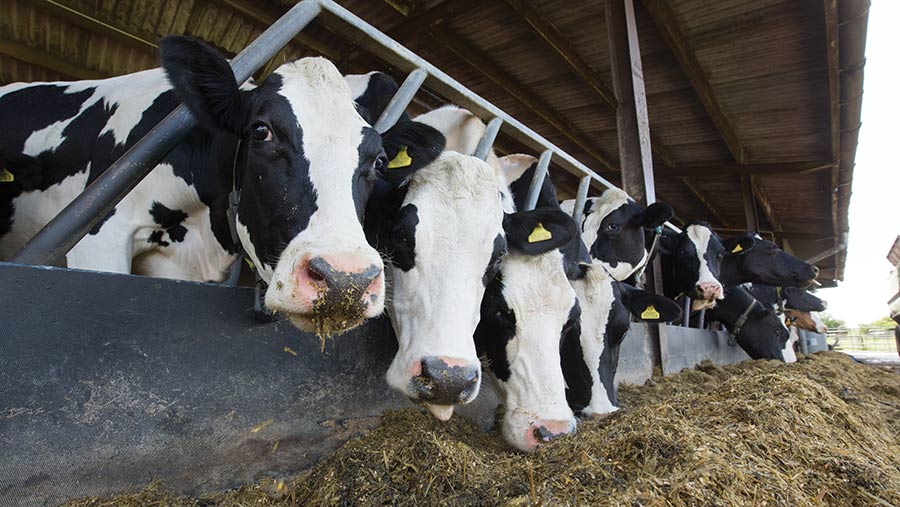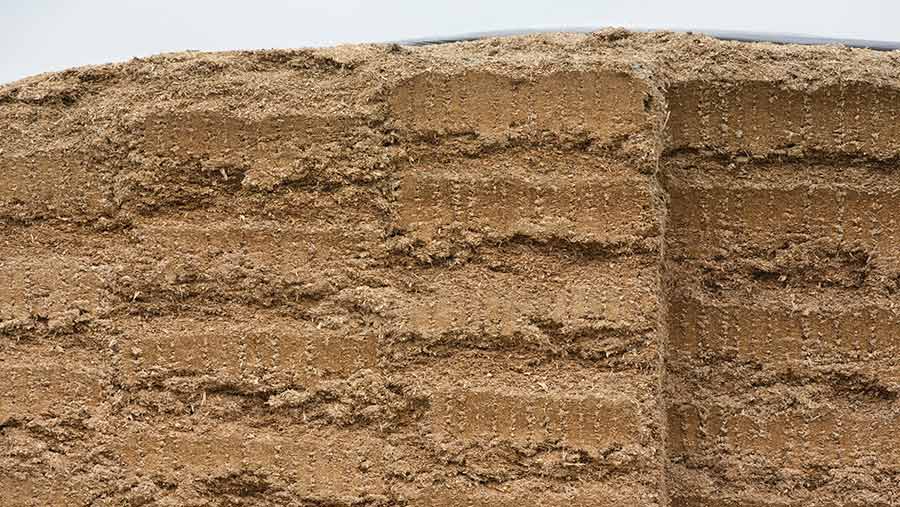Advice on dealing with high mycotoxins in silage
 © Tim Scrivener
© Tim Scrivener The stress caused by very wet and dry conditions during the growing season means maize and wholecrop silages are carrying a high mycotoxin risk this year.
Mycotoxins are formed by fungal pathogens or moulds. If a plant is stressed by factors such as drought, rain or flooding – all of which may have been experienced by some crops this year – they are more susceptible to fungal attack.
If the fungi then become stressed, mycotoxins can be produced. When consumed by the cow, these can cause reduced intakes, milk drop and swollen hocks – symptoms advisers are now seeing on farm.
See also: 5 steps to covering silage pits for an airtight seal
Analysis carried out by Alltech shows the level of type B trichothecenes (formed by fusarium moulds originating in the field) are almost double those seen last year in maize silages.
More than 60% of this year’s maize samples are “higher risk” for mycotoxins (more than 150 parts/bn), compared with 46.7% in 2022.
And wholecrop samples have double the number of mycotoxins of those taken in 2021 and 2022.
At the same time, all silages are continuing a six-yearly trend that has seen penicillium mycotoxins climb year on year (see “Penicillium mycotoxin levels in silages from western Europe, including UK”).
These mycotoxins are largely formed in the clamp and are linked to suboptimal clamp management.
Grass silages tend to be lower risk for field-borne mycotoxins, as grass is cut younger. Maize and wholecrop are more susceptible, as the plant is cut when it is older and has flowered or produced grain.
Signs of mycotoxins
In cows
- Swollen teats, udders and hocks, low dry matter (DM) intakes – these tend to be linked to fusarium mycotoxins
- Low DM intakes – deoxynivalenol (DON), a fusarium mycotoxin, can make the animal feel lethargic and dampens their drive to eat
- Milk drop, poor rumen function (may present like acidosis) and poor performance – these tend to be related to penicillium mycotoxins
In forages
- The presence of visible mould in the field (leaf spots) or in the clamp does not mean that mycotoxins are a problem
- Similarly, the absence of visible mould does not mean that mycotoxins are not an issue
Cow signs
Nutritionist Will Tulley, of Advanced Ruminant Nutrition, says he is seeing depressed dry matter intakes and poorer performance on many farms, translating into about a 1-3 litres a cow a day milk drop.
“This year is a challenging year. We haven’t got far enough in to see if it’s mycotoxins or forage quality. Logically, as it’s a stressful growing season, we’d expect to see more mycotoxins in the clamp,” he says.
On those farms experiencing poor intakes and performance, Will suggests taking the following steps:
- Carry out a detailed forage analysis to quantify how the ration is performing and whether it is balanced correctly to deliver production targets.
- Work with an adviser and assess indicators of rumen function, such as cudding rates and dung consistency, to establish whether ration balance needs correcting or acidosis is an issue.
- Work through the economics of any potential nutritional changes, balancing return on investment.
- If nutritional changes do not bring results, mycotoxin levels may need investigating.
- To maximise cost efficiencies, the total mixed ration can be tested for mycotoxins. This can be expensive and slow, so in smaller herds, or when a rapid result is needed, feeding a broad-spectrum mycotoxin binder may be more appropriate.
- Feed the binder (to milkers and dry cows) for a minimum of two weeks at a higher rate. (Discuss inclusion rates with a nutritionist.)
- Reassess after two weeks.
Will says he has witnessed a general increase in issues related to penicillium mycotoxins over the years, including gut upsets, diarrhoea and individual cow milk drops.
Bob Kendal, regional sales manager for Alltech, has also seen more clinical signs of mycotoxins in cattle this autumn. “Quite a lot of farms are seeing swellings lower down, in [cows’] udders, feet and legs,” he says.
The numbers
- 74.4% The percentage of grass silage samples containing penicillium mycotoxins this year
- 63.6% The percentage of maize silage samples considered “higher” risk for mycotoxins, versus 46.7% last year
- 9.7 The average number of mycotoxins in each sample of wholecrop silage taken this year, versus 4.1 in 2022
Source: Alltech’s UK harvest survey 2023 (samples taken at harvest to establish mycotoxin patterns. 2023 sample size: Maize 11; grass 43; wholecrop 3)
Clamp management

Move quickly across the silage face to prevent mycotoxins © Tim Scrivener
Independent silage specialist Dr Dave Davies believes maize poses “a significant problem” this year in terms of mycotoxin risk.
This is linked to some crops being harvested late because of inclement weather, and plant material dying in the field.
He has also seen a general increase in penicillium mycotoxins, which are largely linked to poor clamp management. However, he believes penicillium species could be forming in the field.
Milder winters without hard frosts mean these moulds could continue to grow in the sward and then be introduced into the clamp.
“If we’re not controlling that clamp incredibly well, we’re allowing the penicillium moulds to grow, which could result in more mycotoxins,” he explains. Allowing air to penetrate the clamp could lead to mycotoxin proliferation.
He advises the following:
Tips for preventing penicillium mycotoxins in the clamp
- Focus on clamp consolidation – roll silage in 15cm layers and consider using a compactor
- Ensure good weight across the top
- Keep the clamp face solid and flat to prevent oxygen penetration
- Move quickly across the face; if you struggle to do this, take partial rather than full blocks of silage with the shear grab
- Consider the impact of silage quality. Preliminary data from research at Harper Adams suggests high acid content (more than 100g/kg dry matter (DM), seems to increase the risk of penicillium moulds in grass silage. As low DM silages of under 28% tend to have higher acid levels, higher DM silages might be at less risk of moulds.
Tips for preventing mycotoxins in the field
- Try and bring clean crops into the clamp
- Clean the swards in the autumn by grazing sheep
- Consider early maturing maize varieties that could be harvested earlier.
At £225 a test, Bob suggests mycotoxin testing becomes cost effective in herds of more than 250 cows. If a mycotoxin binder is used, he stresses the importance of selecting a proven binder that is effective against penicillium mycotoxins.
Penicillium mycotoxin levels in silages from western Europe, including UK |
||||||
| Year | Grass silage | Other fermented silages (maize and wholecrop) | ||||
| Average (parts/bn) | Occurrence (%) | Risk equivalent quantity (parts/bn) | Average (parts/bn) | Occurrence (%) | Risk equivalent quantity (parts/bn) | |
| 2018 | 85.7 | 19.4 | 88.3 | 78.3 | 25.5 | 368.6 |
| 2019 | 601 | 63 | 499.3 | 56.7 | 32.9 | 121.6 |
| 2020 | 251.9 | 55.4 | 233.3 | 96.7 | 35.9 | 190.2 |
| 2021 | 517.1 | 64.3 | 415.8 | 68.1 | 42 | 155.9 |
| 2022 | 686.7 | 64.8 | 537 | 157.9 | 36.5 | 245.9 |
| 2023 | 600 | 68.8 | 502 | 208 | 25 | 208 |
| Six-year average | 457 | 55.95 | 379 | 110 | 32.7 | 215 |
|
Note: Risk equivalent quantity (REQ) attaches a single number to the cumulative risk of mycotoxins in an ingredient or finished feed/total mixed ration sample. A REQ of more than 150ppb is “higher risk”. |
||||||
|
Source: Alltech |
||||||
For more on dairy nutrition, go to fwi.co.uk/know-how/dairy-feed
